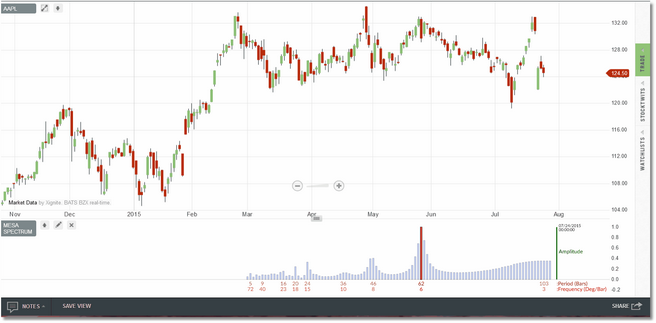The MESA Spectrum indicator calculates the power spectrum of a price data series using the Maximum Entropy Spectrum Estimation method and produces a power spectrum plot in an indicator pane. The Maximum Entropy algorithm, unlike a simple FFT transform, will include frequencies from the entire complex frequency plane and not just the Nyquist interval which, in general terms, means that it can resolve cycle periods that are larger than the data window passed to the function. In addition, MESA has the ability to fit very sharp spectral features which are often missed by other analysis methods. The MESA Spectrum indicator will operate on all bar intervals available in Technician. Also see the MESA Cycles indicator which is the companion to MESA Spectrum.
|
Note: MESA Spectrum is not an indicator that you would typically load into a chart and leave there all day. Rather, it is an indicator that you can load periodically to check on the cycle composition of a security that you are interested in. While you certainly can leave it in place if you so choose, the calculations are very cpu-intensive and it will likely interfere with the overall performance of your chart. |
MESA Spectrum Analyzer running in a daily AAPL chart. In this case the spectrum is based on the most recent 512 price bars on
the chart. If you use your mouse to drag the price bars to the right then the spectrum will change accordingly in that it will always
be based on the 512 price bars up to and including the most recent visible price bar. See the History option under Settings for
more information.
The price data is flattened/detrended prior to processing by the MESA algorithm. The displayed power spectrum will highlight the cycles and frequencies within the data and will display the Period and Frequency below each peak. Period is calculated as the number of bars required to complete a cycle and Frequency is calculated as the number of degrees of change per bar. In addition, you can scroll backwards in the chart and the spectrum will update to reflect the values as of that point in time (see the History parameter in Settings).
P = Bars per Cycle;
F = 360/P (360-degrees divided by period)
An alternative F value can be calculated as number of cycles in the data period N:
F = N/P.
The spectral information can be used as the basis for additional cycle study work or it can be used to fine-tune various oscillators and indicators. The typical approach is to use the MESA Spectrum to identify the
dominant cycle in your data and then set your moving average or oscillator to a period that is 1/2 of the dominant cycle.
|
Note: At times you might see the following message in the MESA Spectrum indicator pane: "Not enough quotes to compute MESA Spectrum". This simply means that there are currently not enough bars of data loaded into the chart to calculate the spectrum, based on the Window size you have selected. The solution is to use your mouse and drag the chart to the right, which will force more bars to be downloaded and displayed in the chart. Once enough bars are present in the chart the calculation will complete. |
|
This indicator is very calculation-intensive and its use is not recommended if you are accessing Technician from a mobile device (i.e., Android or IOS). |
See Also:


